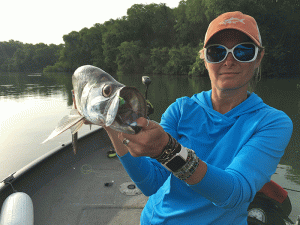Posted on May 21 2019
 By Jen Ripple: Editor-in-Chief of Dun Magazine
By Jen Ripple: Editor-in-Chief of Dun Magazine
The International Fly Tackle Dealer show is returning to Denver this October 16-18 and it’s going to be the single largest show in the history of the event; a veritable who’s-who of the fly fishing industry occupying the Denver Convention Center for three days.
If you’re a writer, photographer, or podcast host looking to hunt for editorial content at IFTD, it’s vitally important to get organized and plan ahead so that you can get the most out of the show. Here are 5 basic best-practices to consider as you look ahead to Denver from AFFTA Board member and Editor-in-Chief of Dun Magazine, Jen Ripple.
-
- Identify your top 2 or 3 topics to cover: Think about this for a minute – IFTD is the single largest opportunity for in-person access to the fly fishing industry. There is no better place to get face-time with the people who are shaping the future of our industry than those three days on the show floor – well, except maybe on the water. While three days access may seem like a lot, it goes blindingly fast if you’re trying to cover too many topics, or if you don’t have an idea of what you want to write about and try to fly by the seat of your pants. So narrow it down. Think about something that others may not be doing, or doing something different with what others are doing. Thoughtful, well-written content about a few items will always win over a pile of thin content trying to cover too much.
- Do your research/legwork: Depending on what topics you pick, do your research and get as much background as you can before you get to the show. Figure out a rough direction you want to take with what you’re writing – is it strictly about new gear, is it about positions on conservation or sustainable business practices, is it an owner profile? Rough out a list of the folks you’re going to need to be in touch with and the questions you want to ask. The more prepared you are, the more you’ll be able to get to the meat of what you need and the less time you’ll waste on uncovering background.
- Schedule your day(s) with your contacts/sources: with 150 exhibitors and attendees numbering in the thousands, it’s easy to get overwhelmed and fall into the well-intended-but-aimless wander, where you make cursory stops at almost every booth, feel like you’re interrupting (which you likely are), and end up with a handshake and “great to see you” but no usable content or conversation. Reach out to those contacts you identified as SMEs in #2 and schedule a specific block of time – shoot for a half-hour unless they can give you more. This will give you an itinerary to follow, and the manufacturers or other industry folks you line up will appreciate the ability to plan ahead as well – their time is valuable at these shows. Line up a strong handful for each of your topics and then leave some time available for the on-the-fly conversations or surprise connections.
- When you register for IFTD, you’ll be able to create your own dashboard on our interactive show-floor tool and schedule those meetings directly with exhibitors. This is a fantastic, free new show resource that you should take full advantage of to make your time at IFTD as productive as possible.
-
For the writers—get plenty of photos & video: Probably the single-best choice you could make would be to partner with one of the many talented photographers in our community and collaborate on your story. Try starting there.
- Short of that, it doesn’t matter whether you’re shooting with a DSLR or your smart phone, just shoot and get as much visual support of your topics as possible. Make sure you get relevant video too because video always performs better on social media. Get plenty of environment footage that doesn’t require audio (meaning general footage around the show floor or of gear, people, etc.). If you shoot interview-style clips, make sure you get close enough to capture decent audio. You’ll be able to edit everything together afterwards, but only if you’ve shot enough to begin with.
- Follow-up with thank yous and additional questions: This should go without saying, but you’d be surprised how often it’s neglected. Relationships are the most important tool in your box, well, except for your writing ability. It doesn’t matter if you’ve known them for a long time or just met at the show, thanking people for their time and consideration only serves to strengthen the working relationship you have. And because you’ve taken the time to show your appreciation, you’ll be far higher on the return email or phone call list for it.
Learn more and register for IFTD at affta.org/iftd-show.
